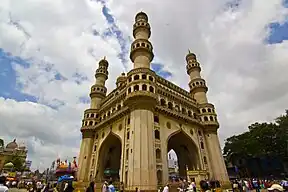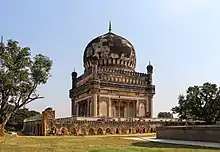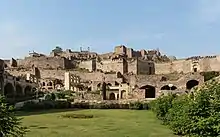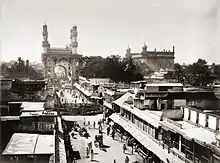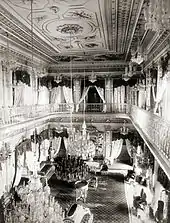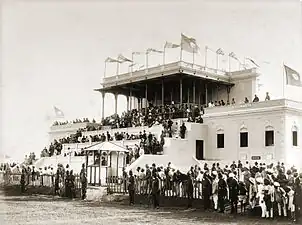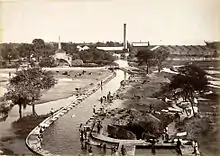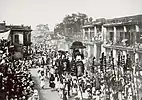History of Hyderabad
Hyderabad was the capital of the Indian states of Telangana and Andhra Pradesh. It is a historic city noted for its many monuments, temples, mosques and bazaars. A multitude of influences has shaped the character of the city in the last 400 years.[1]
The city of Hyderabad was founded by the Qutb Shahi sultan Muhammad Quli Qutb Shah in 1591 CE. It was built around the Charminar, which formed the centerpiece of the city. Hyderabad became an important trading centre for diamonds and pearls, and a centre for culture.[2]
After a brief period of Mughal rule, the first Nizam of Hyderabad conquered the city in 1724. The Nizams later signed a subsidiary alliance with the British, and their territory became Hyderabad State, the largest princely state in British India with the city of Hyderabad as its capital. During this period, industry, railways, modern education, and airways developed in Hyderabad.
After India's independence in 1947, the Nizam did not wish to accede his state to the newly formed nation. By then, his power had weakened due to the Telangana movement. The Indian Army annexed Hyderabad in 1948. In 1956, the Hyderabad State[note 1] was divided on the basis of linguistic differences, and the city of Hyderabad became the capital of Andhra Pradesh.
In 2014, the state of Telangana was carved out from Andhra Pradesh and Hyderabad became its new capital.
Ancient history
Archaeologists excavating near the city have unearthed Iron Age sites that can be dated to 500 BCE.[3] The area around Hyderabad was ruled by the Mauryan Empire in the third century BCE during the reign of Ashoka the Great. After the death of Ashoka (232 BCE), as the Maurya Empire began to weaken and decline, the Sātavāhanas who started out as feudatories to the Mauryan dynasty, declared independence and established their empire in this region. The Sātavāhana Empire was a royal Indian dynasty based from Kotilingala in Telangana as well as Junnar (Pune) and Prathisthan (Paithan) in Maharashtra. The territory of the empire covered much of the Deccan plateau and central India for 450 years,i.e., from 230 BCE onward until around 220 CE. After the decline of the Satavahana Empire in 210 CE, the region came under the rule of the Ikshvaku dynasty (225 CE – 325 CE), the successors of the Satavahanas in eastern Deccan. The capital of Ikshvaku dynasty was the town of Nagarjunakonda in modern day, Guntur district and named after Nagarjuna, a southern Indian master of Mahayana Buddhism who lived in the 2nd century CE, who is believed to have been responsible for the Buddhist activity in the area.
Medieval history
Various Buddhist and Hindu kingdoms ruled the area during the subsequent centuries. The area was ruled by the Kalyani branch of the Chalukya kings. When the Chalukya kingdom became weaker, Kakatiyas, who were feudal chieftains of Chalukya, declared independence and set up their kingdom around Warangal.
The Kakatiyas built the Golkonda Fort in the vicinity of Hyderabad as part of their western defenses along the lines of the Kondapalli Fort. The city and the fortress were built on a granite hill that is 120 metres (390 ft) high, surrounded by massive battlements. The fort was rebuilt and strengthened by Rani Rudrama Devi and her successor Prataparudra.[4][5]
The fall of Warangal to Muhammad bin Tughluq's forces from the Delhi Sultanate in 1321 CE brought anarchy to the region. Later, the Golkonda fort came under the control of the Musunuri Nayaks, who defeated the Tughlaqi army occupying Warangal.[6] For the next few decades, the Bahmani Sultanate of the Deccan fought the Musunuri Nayakas on the north and the Vijayanagara Rayas on the south for control of the region. The Golkonda fort was ceded by the Musunuri Kapaya Nayak to the Bahmani Sultanate as part of a treaty in 1364.[7][8] By the middle of the 15th century, the region was under the firm control of the Bahmani Sultanate, which controlled the Deccan north of the Krishna River from coast to of sultanate.
Under the Bahmani Sultanate, Golkonda slowly rose to prominence. Sultan Quli Qutb-ul-Mulk (r. 1487–1543), sent as a governor of Telangana, established it as the seat of his government around 1501. Bahmani rule gradually weakened during this period, and Sultan Quli formally became independent in 1538, establishing the Qutb Shahi dynasty based in Golkonda.[9][10] Over a period of 62 years, the mud fort was expanded by the first three Qutb Shahi sultans into the present structure, a massive fortification of granite extending around 5 km in circumference. It remained the capital of the Qutb Shahi dynasty until 1590 when the capital was shifted to the present city of Hyderabad.
Time line
Chalukya dynasty (624–1075), Kakatiya dynasty (1158–1321), Khalji dynasty (1290–1320), Tughlaq dynasty (1320–1414), Musunuri Nayakas (1336–1365), Bahmani Sultanate (1347–1527), Qutb Shahi dynasty (1518–1687), Mughal Empire (1526–1857), Asaf Jahi dynasty 1724–1948, Republic of India (1948-till date).
The Qutb Shahi dynasty (1518–1687)
Establishment of the Golconda Sultanate
In 1463, Sultan Muhammad Shah Bahmani II dispatched Sultan Quli Qutb-ul-Mulk to the Telangana region to quell disturbances. Sultan Quli quelled the disturbance and was rewarded as the administrator of the region. He established a base at Kakatiya hill fortress of Golconda, which he strengthened and expanded considerably. By the end of the century, Quli ruled from Golconda as the subedar (governor) of the Telangana region. Quli enjoyed virtual independence from Bidar, where the Bahmani sultanate was then based.
In 1518, when the Bahmani Sultanate disintegrated into five different kingdoms, with the others based in Ahmednagar, Berar, Bidar and Bijapur. Sultan Quli declared independence from the Bahmani Sultanate and established the Golconda Sultanate under the title "Sultan Quli Qutub Shah",[12] he rebuilt the mud-fort of Golconda and named the city Muhammad Nagar.[13][14]
The Hussain Sagar lake was built during the reign of Ibrahim Quli Qutb Shah, the fourth Sultan of the dynasty, in 1563. It was named after Hussain Shah Wali, who helped design it.[15]
Founding of Hyderabad

In 1589, Muhammad Quli Qutb Shah,[16] the fifth ruler of the Qutb Shahi dynasty, selected the present site of the city and established the city of Hyderabad at the banks of the Musi river to overcome water shortages experienced at Golconda.[17] The Purana Pul (old bridge) enabled quick travel between Golconda and Hyderabad.[18]
There are various theories about the naming of the city. One popular theory suggests that the sultan had named the city "Bhaganagar" or "Bhāgyanagar" after Bhāgmathi, a local nautch (dancing) girl with whom he had fallen in love.[19] She converted to Islam and adopted the title Hyder Mahal.[20] The city was renamed Hyderabad in her honour.[19] According to another source, the city was named after Haidar, the son of Quli Qutb Shah.[21] Historians dismiss the theory of dancing girl as a "figment of the imagination" that lacks a "shred of evidence". According to the Hyderabad-based historian Capt. Panduranga Reddy (retd) who studied the city's origin, "It is all fiction that Hyderabad was ever named Bhagyanagar or that it was named after the lover of Mohammad Quli Qutb Shah. Hyderabad was actually built much later around a small village called Chichulam."[22]
The architectural historian Pushkar Sohoni theorised the foundation of several cities in the Deccan in this period.[23] According to him, Hyderabad was founded in 1591 to decongest Golconda, which was growing rapidly. In addition, the changing nature of economic organisation and warfare technology required mercantile and civilian settlements to be disaggregated from the fortified military and political centres.[24] Andrew Petersen, a scholar of Islamic architecture, says the city was originally called Baghnagar (city of gardens).[25]
He ordered the construction of the Charminar in 1591. The construction of the nearby Makkah Masjid was also started during his reign, but would not be completed for a hundred years.[26][11] Mir Momin Astarabadi, the prime minister in the Qutub Shahi period, developed the plan of the city of Hyderabad, including the location of the Charminar and Char Kaman.[27][28][29]
Growth of the new city, Hyderabad
The early history of Hyderabad is inextricably intertwined and fortune rose during the 16th and early 17th centuries, Hyderabad became a center of a vibrant diamond trade. All eight Qutb Shahi sultans were patrons of learning and were great builders. They contributed to the growth and development of Indo-Persian and Indo-Islamic literature and culture in Hyderabad. Some of the sultans were known as patrons of local Telugu culture as well. During the Qutb Shahi reign Golconda became one of the leading markets in the world for diamonds, pearls, steel, arms, and also printed fabric. In the 16th century, the city grew to accommodate the surplus population of Golconda and eventually became the capital of the Qutb Shahi rulers. Hyderabad became known for its baghs (gardens) and its comfortable weather.
Mughal conquest and rule (1687–1724)

By the mid-17th century, politics in the Deccan were ready for yet another tectonic shift. Mughal prince Aurangzeb spent most of his time in the Deccan fighting local Hindu and Muslim kingdoms to establish and enforce Mughal sovereignty. After the death of Shah Jahan in 1666, Aurangzeb consolidated his power in Delhi as Emperor and returned to the south. He spent most of his imperial reign in military camps in the Deccan, in an almost desperate campaign to expand the empire beyond the greatest extent it had reached under Akbar. The biggest prize in his eyes was the rich city of Hyderabad, protected by the reportedly impregnable fort of Golconda.[30]
Aurangzeb with his commanders Khwaja Abid Siddiqi (Qulich Khan) and the latter's son Ghazi-ud-Din Feroze Jung laid siege to Golconda in 1686. Golconda held fast under months of siege, and Aurangzeb had to retreat in frustration. Aurangzeb returned in 1687 and laid siege for 9 months camping in the Fateh Maidan ("victory field", now the Lal Bahadur Shastri Stadium).[31] Khwaja Abid Siddiqi died in these war and was buried at Kismatpur near Attapur, Hyderabad. Local legend has it that the fortress held on, but the gates were opened at night by a saboteur Abdullah Khan Pani who was bribed by Aurangzeb. Hyderabad's independence was eclipsed.
On 21 September 1687, the Golkonda Sultanate came under the rule of the Mughal emperor Aurangzeb after a year-long siege of the Golkonda fort.[32][33] The annexed city "Hyderabad" was renamed Darul Jihad (House of War),[34] and the main territories of the Golconda Sultanate were made into the province Hyderabad Subah.[35]
Mubariz Khan was appointed as the Governor of the Deccan province.[36] Aurangzeb's efforts would turn out largely in vain, with Hyderabad remaining under Mughal rule for less than four decades. During this period, the construction of the Makkah Masjid (which had started in the 16th century) and city wall of Hyderabad with 12 gateways[37] was completed.
For a few decades, Hyderabad declined, and its vibrant diamond trade was all but destroyed. Aurangzeb's attention moved away quickly to other parts of the Deccan, with the Maratha Empire gaining ground against the Mughals.
The Nizams of Hyderabad (1724–1948)
Hyderabad State, (its capital and largest city Hyderabad) under the Nizams of Hyderabad, was the largest princely state in India, with an area larger than England, Scotland and Wales combined. It was considered the "senior-most" princely-state, and within the elaborate protocols of the Raj, its ruler the Nizam was accorded a 21-gun salute. Development of modern facilities and industrialization in Hyderabad city started in the late 19th century.[38] The State had its own currency, mint, railways, and postal system. The Nizam amassed a lot of wealth, as a result of the diamond trade.[39]
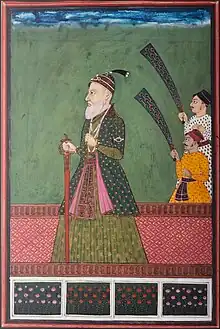
Asaf Jah I
With the emaciation of the Mughal Empire after Aurangzeb's death in 1707, the Mughal-appointed governors of Hyderabad gained more autonomy from Delhi. In 1714, the Mughal Emperor Farrukhsiyar appointed Mir Qamar-ud-din Siddiqi as the viceroy to the Deccan and gave him the title of Nizam-ul-Mulk (governor of the country).[40] He was well suited for the position as he had fought alongside his father and grandfather who were commanders during the siege of Golconda.
In 1724, he defeated Mubariz Khan to establish control over Hyderabad.[41] He received the title of Asaf Jah from Mughal Emperor Muhammad Shah in the following year. Thus began the Asaf Jahi dynasty that would rule Hyderabad until a year after India's independence from Britain.[31][42]
Successors of Asaf Jah I
The death of Asaf Jah I in 1748 resulted in a period of political unrest as his sons, backed by opportunistic neighboring states and colonial foreign forces, contended for the throne. The accession of Asif Jah II, who reigned from 1762 to 1803, ended the instability. In 1768 he signed the Treaty of Machilipatnam, surrendering the coastal region to the East India Company in return for a fixed annual rent.[43]
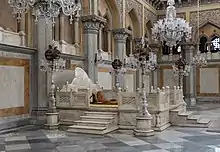
In 1769 Hyderabad city became the formal capital of the Nizams.[44][45] In response to regular threats from Hyder Ali (Dalwai of Mysore), Baji Rao I (Peshwa of the Maratha Empire), and Basalath Jung (Asaf Jah II's elder brother, who was supported by the Marquis de Bussy-Castelnau), the Nizam signed a subsidiary alliance with the East India Company in 1798, allowing the British Indian Army to occupy Bolarum (modern Secunderabad) to protect the state's capital, for which the Nizams paid an annual maintenance to the British.[43]
When the British and the French spread their hold over the country, successive Nizams won their friendship without bequeathing their power. The Nizams allied themselves with each side at different times, playing a significant role in the Anglo-Mysore Wars.
During the reign of the third Nizam, Sikandar Jah, the city of Secunderabad was founded to station French troops and subsequently, British troops.[31] The British stationed a Resident at Hyderabad and their own troops at Secunderabad, but the state continued to be ruled by the Nizam. Maintenance of British forces, which was part of subsidiary alliance with British, put heavy burden on Hyderabad state and bankrupted it in the early 19th century.[46]
Asaf Jah V
Asaf Jah V's reign was marked by reforms by his Prime Minister Salar Jung I, included the establishment of a governmental central treasury in 1855. He reformed the Hyderabad revenue and judicial systems, instituted a postal service and constructed the first rail and telegraph networks. The first higher educational institution of Hyderabad known as Dar-ul-Uloom was established during his reign.[47][48]
As news of the Indian Rebellion of 1857 reached Hyderabad, Turrebaz Khan and Maulvi Allauddin led rebellions of about 5,000 people and attacked the British Residency. However, this was no match for the superior British troops and the rebellion was quickly crushed.[49][50][51]
Asaf Jah VI
Asaf Jah VI Mir Mahbub Ali Khan was the sixth Nizam of Hyderabad. He ruled the state from 1866 till his death in 1911.[54][55] He inherited the throne at the age of three, and the state was ruled by his regents Salar Jung I and Shams-ul-Umra III.[56] The Nizam assumed full rule at the age of eighteen.[57][58]
The Nizam's Guaranteed State Railway was established in 1879, a railway company fully owned by the Nizam. It was formed to connect Hyderabad with the rest of the British India, and was headquartered at Secunderabad Railway Station. After independence, it was integrated into the Indian Railways. The introduction of railways also marked the beginning of industry in Hyderabad, and four factories were built to the south and east of the Hussain Sagar lake.[59]
The population of Hyderabad city reached 448,000 in 1901, making it the fourth most populous in British India. The surrounding Hyderabad State had a population of 11 million.[60]
The Great Musi Flood of 1908 ravaged the city during his reign, killing an estimated 15,000 people and affecting at least 200,000.[61][62][63] All the bridges over the River Musi were destroyed, except for the Purana Pul. The Nizam threw open his palace Purani Haveli for the flood victims.[64]
To my horror, I found that three leaks had started and were rapidly extending. The breach of this dam would precipitate an enormous volume of water into the still greater Hosain Sagar Lake, probably cause the dam to burst and thus complete the destruction of Hyderabad city,
— Michael O'Dwyer, British Resident
The flood necessitated planned development of the city. The Nizam invited Sir M. Visvesvaraya to design the flood prevention system of modern Hyderabad.[65]
The Nizam died in 1911 at the age of 45.[66]
Asaf Jah VII
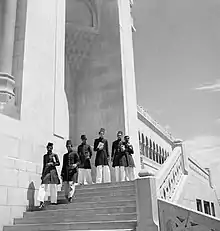
The seventh and last Nizam of Hyderabad, Mir Osman Ali Khan ascended the throne in 1911.[66]
He founded numerous institutions and public buildings in the city, including the Begumpet Airport, Hyderabad State Bank, Osmania University, Nizamia Observatory, Moazzam Jahi Market,[67][68] Nizamia Hospital, Assembly Hall (formerly known as the Town Hall) State Central Library (formerly known as the Asafiya Library), Hyderabad High Court.[69] and the Osmania General Hospital. The Nizam also invited British architect Vincent Esch for designing some of these. The Nizam also owned an airline, called the Deccan Airways.[70][71]
Two large reservoirs, namely the Osman Sagar and the Himayat Sagar were constructed a few kilometers west of Hyderabad to prevent another flood in the city, on the advice of Sir M. Visvesvaraya.[72][73]
He was known for his immense wealth, and large jewel collection, composed of 173 jewels, including the Jacob Diamond.[74] He was proclaimed the richest man in the world in 1937, and appeared on the cover of Time magazine owing majorly to the Golconda mines, which were the primary source of his wealth.
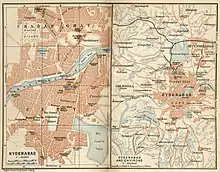
Various industries emerged in pre-independence Hyderabad during the rule of Asaf Jah VII. The major industries that were established in various parts of Hyderabad, and surrounding areas are:[75][76][77]
| Company | Year |
|---|---|
| Karkhana Zinda Tilismat | 1920 |
| Singareni Collieries | 1921 |
| Vazir Sultan Tobacco Company,Charminar cigarette factory | 1930 |
| Azam Jahi Mills Warangal | 1934 |
| Nizam Sugar Factory | 1937 |
| Allwyn Metal Works | 1942 |
| Praga Tools | 1943 |
| Deccan Airways Limited | 1945 |
| Hyderabad Asbestos | 1946 |
| Sirsilk | 1946 |
Post-Independence (1948–present)
Integration into the Indian Union
When India gained independence in 1947, the Nizam declared his intention to remain independent, either as a sovereign ruler or by acquiring Dominion status within the British Commonwealth. In order to keep essential trade and supplies flowing, he signed a Standstill agreement with the Indian Union, which surrounded him on all sides. The law and order situation soon deteriorated, with escalating violence between the private Razakar army fighting for continuation of the Nizam's rule and the people with the support of the Congress leaders like Swami Ramanand Tirtha and the communists of Telangana, were fighting for joining the Union. As the violence spiraled out of control with refugees flowing into the coastal Andhra region of the Madras state of India, the Indian Government under Home Minister Sardar Patel initiated a police action titled Operation Polo.[78][79]
On 16 September 1948, the Indian Army moved into Hyderabad State from five fronts. Four days later, the Hyderabad forces surrendered. The number of dead was a little over 800. The Police Action achieved success within a matter of days. The Nizam finally surrendered and signed the Instrument of Accession to the Indian Union and Hyderabad was integrated into the Union as a state.
Hyderabad State
The state got its first democratic government and the representatives of its 18 million people were admitted to the Constituent Assembly drafting a constitution for free India. For the next eight years, Hyderabad State continued as a separate state within the Union, with its capital Hyderabad.

Demand for Second capital of India
In 1955, in a report Thoughts on Linguistic States, B. R. Ambedkar the then chairman of the Drafting Committee of the Indian Constitution, expressed in his report that the city should be designated as the second capital of India after Delhi. As Hyderabad constitute a strategic central location, infrastructure and amenities.[80] He expressed: "Hyderabad has all the amenities which Delhi has and it is a far better city than Delhi. It has all the grandeur which Delhi has. Buildings are going cheap and they are really beautiful buildings, far superior to those in Delhi. The only thing that is wanting is a Parliament House which the Government of India can easily build."[81] In 2014, the demand resurfaced during the bifurcation of Andhra Pradesh,[82] and in 2019, during the reorganisation of Jammu and Kashmir.[83]
1956–present
On 1 November 1956, the states of India were reorganized on linguistic grounds and the 7th Nizam Mir Osman Ali Khan was made the Rajpramukh based on his administrative abilities. Consequently, the territories of the State of Hyderabad were divided between newly created Andhra Pradesh, Bombay state (later Maharashtra), and Karnataka. Hyderabad and the surrounding areas were annexed into India, and later to Andhra Pradesh based on Telugu linguistic majority, and Hyderabad became the capital of the new state of Andhra Pradesh. Since 1956, Rashtrapati Nilayam, Hyderabad has been the second official residence and business office of the President of India.[84]
HITEC City was launched in the 1990s as by the Andhra Pradesh government. Today, many multinational IT Companies including Amazon, Infosys, Cognizant, Microsoft, Tech Mahindra and HCL have offices in HITEC City, and the surrounding localities of Gachibowli and Madhapur. In 2005, construction began for the Rajiv Gandhi International Airport, which was completed and opened in 2008, to replace the old Begumpet Airport.[85] It is one of the busiest airports in India.

The city saw terrorist bomb blasts in May 2007, August 2007 and February 2013.[86]
Hyderabad also hosted the 2007 Military World Games and 2009 World Badminton Championships.[87]
By the Andhra Pradesh Reorganization Act, 2014, Telangana was separated from Andhra Pradesh as a new 29th state of India, with the city of Hyderabad as its capital. The new state was created on 2 June 2014.[88] K. Chandrashekhar Rao was elected as the first Chief Minister of Telangana. Hyderabad would also remain the de jure capital of Andhra Pradesh for a period of ten years.
The Hyderabad Metro Rail began operations in 2017, five years after its groundbreaking in 2012. Many of the routes are still under construction.[89]
Gallery
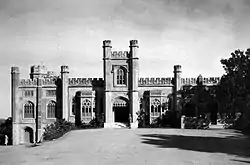 The Hill Fort Palace, 1930s
The Hill Fort Palace, 1930s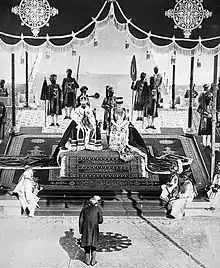
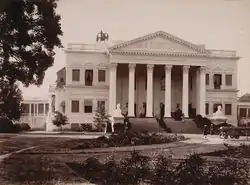 British Residency, Hyderabad, 1880s
British Residency, Hyderabad, 1880s
 Distant view of Hyderabad, 1880s
Distant view of Hyderabad, 1880s One Hyderabadi Rupee coin issued in 1329 AH (1911 CE) during the reign of Asaf Jah VI
One Hyderabadi Rupee coin issued in 1329 AH (1911 CE) during the reign of Asaf Jah VI Map of Hyderabad, 1911
Map of Hyderabad, 1911
References
Notes
- Hyderabad State (1724–1948) is not to be confused with Hyderabad State (1948–1956). The former was a princely state ruled by the Nizams, and the latter was a state of the Republic of India
Citations
- Ahmed, Akbar S. (1 November 2002). Discovering Islam: Making Sense of Muslim History and Society. Routledge. ISBN 9781134495429.
- "History & Culture | Hyderabad District, Government of Telangana | India". Retrieved 18 December 2020.
- Venkateshwarlu, K. (10 September 2008). "Iron Age burial site discovered". The Hindu. Archived from the original on 13 September 2008. Retrieved 7 June 2013.
- Sardar, Golconda through Time 2007, pp. 25–26.
- Saqi Mustaid Khan, Ma'asir-i-Alamgiri, Translated by Jadunath Sarkar, Royal Asiatic Society of Bengal, Kolkata (then Calcutta); 1947, p. 183
- Sardar, Golconda through Time 2007, p. 44.
- Prasad, History of the Andhras 1988, p. 172.
- Sardar, Golconda through Time 2007, p. 20.
- Sardar, Golconda through Time 2007, pp. 66–67.
- Sen, Sailendra (2013). A Textbook of Medieval Indian History. Primus Books. p. 118. ISBN 978-9-38060-734-4.
- "The Qutb Shahi Monuments of Hyderabad Golconda Fort, Qutb Shahi Tombs, Charminar". UNESCO World Heritage Centre. Archived from the original on 1 February 2018. Retrieved 28 September 2018.
- Sardar, Marika (2007). Golconda through time: a mirror of the evolving Deccan. pp. 19–41. ISBN 978-0-549-10119-2.
- Jaisi, Sidq (2004). The nocturnal court: life of a prince of Hyderabad. Oxford University Press. pp. 29–30. ISBN 978-0-19-566605-2.
- Sastri, Kallidaikurichi Aiyah Nilakanta (1976). A history of south India from prehistoric times to the fall of Vijayanagar. Oxford University Press. p. 192. ISBN 0-19-560686-8.
- Nayeem, M.A (28 May 2002). "Hyderabad through the ages". The Hindu. Retrieved 18 December 2013.
- Matsuo, Ara (22 November 2005). "Golconda". University of Tokyo. Retrieved 18 December 2013.
- Haig, Historic Landmarks of the Deccan 1907, pp. 217.
- Bosworth, Clifford Edmund (2007). Historic cities of the Islamic World. BRILL. p. 164. ISBN 9789004153882. Retrieved 20 June 2013.
- Aleem, Shamim; Aleem, M. A. (1984). Developments in Administration Under H.E.H. the Nizam VII. Osmania University Press.
- Haig, Historic Landmarks of the Deccan 1907, pp. 211.
- McCann, Michael W. (1994). Rights at work: pay equity reform and the politics of legal mobilization. University of Chicago Press. p. 6. ISBN 0-226-55571-2.Haig, Historic Landmarks of the Deccan 1907, pp. 210
- The march of India. Publications Division, Ministry of Informations and Broadcasting, Government of India. 1959. p. 89. Retrieved 7 January 2013.
- Khan, Masud Ḥusain (1996). Mohammad Quli Qutb Shah. Sahitya Akademi. pp. 14–15. ISBN 978-81-260-0233-7. Retrieved 7 January 2013.
- Reddy, Gayatri (2005). With respect to sex: negotiating hijra identity in south India. University of Chicago Press. p. 6. ISBN 0-226-70755-5.
- Kakar, Sudhir (1996). The colors of violence: cultural identities, religion, and conflict. University of Chicago Press. p. 23. ISBN 0-226-42284-4.
- "Opinion A Hyderabadi conundrum". 15 November 2018.
- Room, Adrian (2006). Placenames of the world: origins and meanings of the names for 6,600 countries, cities, territories, natural features and historic sites. McFarland. p. 171. ISBN 978-0-7864-2248-7. Retrieved 8 January 2013.
- Swamy, Rohini (7 December 2018). "Yogi is wrong. There's not a shred of evidence to prove Hyderabad was called Bhagyanagar". ThePrint. Retrieved 7 December 2020.
- Sohoni, Pushkar (2015). "From Defended Settlements to Fortified Strongholds: Responses to Gunpowder in the Early Modern Deccan". South Asian Studies. 31 (1): 111–126. doi:10.1080/02666030.2015.1008818. S2CID 162270390.
- Sohoni, Pushkar (2015). "From Defended Settlements to Fortified Strongholds: Responses to Gunpowder in the Early Modern Deccan". South Asian Studies. 31 (1): 113. doi:10.1080/02666030.2015.1008818. S2CID 162270390.
- Petersen, Andrew (1996). Dictionary of Islamic architecture. Routledge. p. 112. ISBN 0-415-06084-2.
- Haig, Historic Landmarks of the Deccan 1907, pp. 210.
- "Here sleeps the earliest urban planner". The Hindu.
- "Viola! Not 2, world has 84 Hyderabads". The Times of India.
- "Hyderabad blueprint drafted in the name of Haidar". The Times of India.
- Roy, Kaushik (30 March 2011). War, Culture and Society in Early Modern South Asia, 1740–1849. Taylor & Francis. ISBN 9781136790874.
- Briggs, Henry George (March 2007). The Nizam – His History and Relations with the British Government -. Read Books. ISBN 9781406710946.
- Richards, J. F. (1975). "The Hyderabad Karnatik, 1687–1707". Modern Asian Studies. Cambridge University Press. 9 (2): 241–260. doi:10.1017/S0026749X00004996. S2CID 142989123.
- Hansen, Waldemar (1972). The Peacock throne: the drama of Mogul India. Motilal Banarsidass. pp. 168 and 471. ISBN 81-208-0225-X.
- Nanisetti, Serish (13 December 2017). "Living Hyderabad: drum house on the hillock". The Hindu. Retrieved 19 December 2017.
- Richards, J. F. (1975). "The Hyderabad Karnatik, 1687-1707". Modern Asian Studies. 9 (2): 241–260. doi:10.1017/S0026749X00004996. ISSN 0026-749X. JSTOR 311962. S2CID 142989123.
- Bilgrami & Willmott 1883, pp. 68–69.
- Bilgrami, 1927, pp. 94–95.
- "Historical Events of Hyderabad". Hyderabad planet. Retrieved 27 July 2012.
- "34-carat diamond, once owned by Nizam of Hyderabad, up for auction in US". NDTV.com, Hyderabad. 16 April 2013.
- Mehta, J. L. (Jaswant Lal) (2005). Advanced study in the history of modern India 1707–1813. Slough, Berkshire, UK: New Dawn Press. ISBN 1932705546. OCLC 61811853.
- Bilgrami & Willmott 1883, pp. 69–70.
- Law, Modern Hyderabad (Deccan) 1914, pp. 22–23.
- Regani, Sarojini (1988). Nizam-British relations, 1724–1857. Concept Publishing. pp. 130–150. ISBN 81-7022-195-1.
- Farooqui, Salma Ahmed (2011). A comprehensive history of medieval India. Dorling Kindersley. p. 346. ISBN 978-81-317-3202-1.
- Malleson, George Bruce (2005). An historical sketch of the native states of India in subsidiary alliance with the British government. Asian Education Services. pp. 280–292. ISBN 978-81-206-1971-5.
- Townsend, Meredith (2010). The annals of Indian administration, Volume 14. BiblioBazaar. p. 467. ISBN 978-1-145-42314-5.
- Richards, J. F. (1975). "The Hyderabad Karnatik, 1687–1707". Modern Asian Studies. Cambridge University Press. 9 (2): 241–260. doi:10.1017/S0026749X00004996. S2CID 142989123.
- Ikram, S. M. (1964). "A century of political decline: 1707–1803". In Embree, Ainslie T (ed.). Muslim civilization in India. Columbia University. ISBN 978-0-231-02580-5. Archived from the original on 6 March 2012. Retrieved 7 October 2011.
- Rao, Sushil (11 December 2009). "Testing time again for the pearl of Deccan". The Times of India. Archived from the original on 10 September 2015. Retrieved 22 April 2012.
- A Gazetteer of the World. Royak Geographica society, Great Britain. 1856. Retrieved 27 July 2012.
- Law, Modern Hyderabad (Deccan) 1914, pp. 31–37.
- Leonard, Karen Isaksen (2007). Locating Home: India's Hyderabadis Abroad. Stanford University Press. pp. 19–20. ISBN 9780804754422.
- "Is this the Residency?". The Hindu. 17 July 2007. ISSN 0971-751X. Retrieved 1 October 2018.
- Daftuar, Swati (29 July 2016). "The tale of Turram Khan". The Hindu. ISSN 0971-751X. Retrieved 1 October 2018.
- Bilgrami & Willmott 1883, pp. 113–114.
- Law, Modern Hyderabad (Deccan) 1914, pp. 5–9.
- Deepali, Dewan (2013). Raja Deen Dayal : artist-photographer in 19th-century India. Deen Dayal, Raja, 1844–1905,, Hutton, Deborah S. [New Delhi, India]. ISBN 9788189995768. OCLC 840408115.
{{cite book}}: CS1 maint: location missing publisher (link) - "Nizam of Hyderabad Dead.; Premier Prince of Indian Empire Had Annual Income of $10,000,000". The New York Times. Retrieved 5 August 2018.
- "585 Bilkees I. Latif, The soul of Hyderabad". www.india-seminar.com. Retrieved 5 August 2018.
- Law, Modern Hyderabad (Deccan) 1914, pp. 35.
- Lynton, Days of the Beloved 1987, pp. 36–37.
- Law, Modern Hyderabad (Deccan) 1914, pp. 27–28.
- Dayal, Deen (2013). "The mills, Hyderabad". Europeana. Archived from the original on 1 January 2016. Retrieved 31 October 2015.
- Great Britain, India Office; Hunter, William Wilson; Cotton, James Sutherland; Burn, Richard; Meyer, William Stevenson (1907). The Imperial Gazetteer of India. University of California Libraries. Oxford : Clarendon Press.
- Lynton, Days of the Beloved 1987, pp. 13–15.
- "When the Musi rose in fury: Remembering the devastating Hyderabad flood of 1908". The News Minute. 26 September 2016. Retrieved 2 October 2018.
- "Hyderabad to observe 104th anniversary of Musi flood | The Siasat Daily". archive.siasat.com. 20 September 2012. Retrieved 5 August 2018.
- Nanisetti, Serish (27 September 2018). "The 1908 Hyderabad flood in retrospect". The Hindu. ISSN 0971-751X. Retrieved 2 October 2018.
- "Mokshagundam Visvesvaraya: Model engineer and scholar". Hindustan Times. 14 January 2020. Retrieved 21 April 2020.
- Law, Modern Hyderabad (Deccan) 1914, pp. 28.
- "Moazzam Jahi market is not just a bazaar – Times of India". The Times of India. Retrieved 29 July 2018.
- "Historical Moazzam Jahi Market lies in neglect | The Siasat Daily". archive.siasat.com. 16 September 2014. Retrieved 29 July 2018.
- Ifthekhar, J. S. (9 May 2012). "Nizam, a forward-looking ruler". The Hindu. ISSN 0971-751X. Retrieved 31 July 2018.
- Lasania, Yunus Y. (25 February 2017). "The last Nizam of Hyderabad was not a miser". The Hindu. ISSN 0971-751X. Retrieved 21 July 2018.
- Khan, Sarah. "Returning to Hyderabad, Once a Land of Princes and Palaces". The New York Times. Retrieved 21 July 2018.
- "Osman Sagar Lake, History of Osman Sagar Lake, Adventure at Osman Sagar Lake : Eco India". www.ecoindia.com. Retrieved 21 July 2018.
- "History of Osman Sagar and Himayat Sagar Lakes of Hyderabad – Hyderabad Tourism". Explore Telangana. 14 September 2014. Retrieved 21 July 2018.
- Splendor, Order Of (11 February 2013). "From Her Majesty's Jewel Vault: The Nizam of Hyderabad Rose Brooches and Necklace". From Her Majesty's Jewel Vault. Retrieved 21 July 2018.
- "Kaleidoscopic view of Deccan". The Hindu. 25 August 2009. ISSN 0971-751X. Retrieved 21 July 2018.
- "VST Industries > Company History > Cigarettes > Company History of VST Industries – BSE: 509966, NSE: VSTIND". www.moneycontrol.com. Retrieved 21 July 2018.
- "Trituradora de piedra,Fabricantes de equipos de molienda,Fabricación de dispositivos móviles". www.zindatilismath.in. Archived from the original on 21 January 2016. Retrieved 21 July 2018.
- Clyde Eagleton, "The Case of Hyderabad Before the Security Council" American Journal of International Law 44#2 (1950), pp. 277–302 online
- Taraknath Das, "The Status of Hyderabad During and After British Rule in India" American Journal of International Law 43#1 (Jan., 1949), pp. 57–72 online
- "Dr. Babasaheb Abmedkar : Writings and Speeches" (PDF). Ministry of External Affairs (India). Retrieved 21 December 2020.: 170–171
- Ambedkar, Mahesh (2005). The Architect of Modern India Dr Bhimrao Ambedkar. Diamond Pocket Books. pp. 132–133. ISBN 978-81-288-0954-5.
- "Ambedkar for Hyderabad as second capital of India". Ambedkar.org. 1955. Retrieved 17 May 2010.
- "Andhra Pradesh leaders demand to make Hyderabad second capital of India". The Economic Times. 7 August 2013. Retrieved 21 December 2020.
- "G Kishan Reddy: No plan to make Hyderabad India's 2nd capital". Deccan Chronicle. 18 November 2019. Retrieved 21 December 2020.
- "Rashtrapati bhavan:presidential retreats". presidentofindia.nic. Retrieved 26 May 2012.Vohra, J.N. (8 July 2007). "Palaces of the President". The Tribune. Retrieved 26 May 2012.
- "New Hyd airport opening takes off with SpiceJet flights". 22 April 2016. Archived from the original on 22 April 2016. Retrieved 5 August 2018.
- "Hyderabad blasts: 16 killed, 119 injured Photo Gallery, Picture News Gallery – The Indian Express". 24 February 2013. Archived from the original on 24 February 2013. Retrieved 31 July 2018.
- "India to host 2009 Badminton Worlds". dna. 9 December 2005. Retrieved 31 July 2018.
- "Notification" (PDF). The Gazette of India. Government of India. 4 March 2014. Retrieved 4 March 2014.
- "Hyderabad Metro rail flagged off today: See fares, timings, routes and other features". The Indian Express. 28 November 2017. Retrieved 31 July 2018.
Further reading
- Prasad, G. Durga (1988), History of the Andhras up to 1565 A. D. (PDF), Guntur: P. G. Publishers
- Sardar, Marika (2007), Golconda through Time: A Mirror of the Evolving Deccan (PhD thesis, New York University), ISBN 978-0-549-10119-2
- Zubrzycki, John. (2006) The Last Nizam: An Indian Prince in the Australian Outback. Pan Macmillan, Australia. ISBN 978-0-330-42321-2.
- Haig, Sir Thomas Wolseley (1907), Historic Landmarks of the Deccan, ISBN 978-0265175248
- Lynton, Harriet Ronken (1987), Days of the Beloved, Orient Blackswan, ISBN 978-0863112690
- Law, John (1914), Modern Hyderabad (Deccan), Thacker, Spink & Company
- Bilgrami, Syed Hussain; Willmott, C. (1883), Historical and descriptive sketch of His Highness the Nizam's dominions, Bombay, Printed at the Times of India Steam Press
- Bilgrami, Syed Ali Asgar (1927). Landmarks of the Deccan. Government Central Press, Hyderabad.
